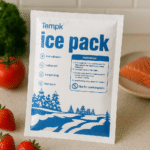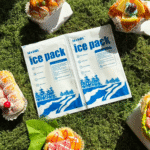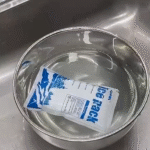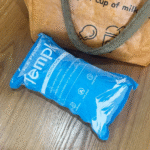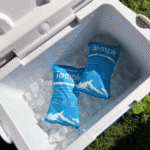Cómo utilizar bolsas de hielo seco para el envío de mariscos 2025
El envío de productos del mar no se trata sólo de velocidad: se trata de mantener la temperatura adecuada desde el muelle hasta la puerta. Las bolsas de hielo seco ofrecen una refrigeración fiable sin agua sucia, haciéndolos ideales para el envío de mariscos congelados. En 2025, Las regulaciones y las expectativas de los clientes son más estrictas que nunca., Por eso, esta guía le muestra cómo elegir la cantidad adecuada de hielo seco., preparar el embalaje, cumplir con las reglas de seguridad, y aprovechar las últimas innovaciones. Con los métodos correctos, puedes entregar mariscos que saben como recién pescados.
-
Comprenda cómo funcionan las bolsas de hielo seco y por qué son esenciales para los envíos de productos del mar congelados – incluida su sublimación a temperaturas ultrabajas y enfriamiento sin humedadtempcontrolpack.com.
-
Calcule la cantidad de hielo seco necesaria para diferentes tiempos de tránsito y tamaños de paquetes – utilizando fórmulas prácticas y ejemplos del mundo realtempcontrolpack.com.
-
Elija los materiales de embalaje y aislamiento adecuados – incluidos contenedores a prueba de fugas, revestimientos de poliestireno, y ventilación para liberar de forma segura el gas dióxido de carbono.fedex.com.
-
Cumplir con 2025 regulaciones, requisitos de etiquetado, y directrices de seguridad para envíos de hielo seco – entender la ONU 1845 etiquetado, límites de peso, y documentación de mercancías peligrosasbarcomercury.com.
-
Manténgase a la vanguardia de las tendencias e innovaciones de la industria – como contenedores inteligentes, aislamiento ecológico, y mejora de la producción de hielo secotempcontrolpack.com.
¿Por qué elegir bolsas de hielo seco para el envío de mariscos??
Las propiedades únicas del hielo seco mantienen los mariscos congelados
El hielo seco es dióxido de carbono sólido. A diferencia de los paquetes regulares de hielo o gel, él Susilimaciones—pasa directamente de sólido a gas—a –78,5°C (–109.3 ° F). Este proceso absorbe el calor y mantiene una temperatura ultrabaja sin dejar residuos de agua.nexair.com. La falta de humedad mantiene intacta la textura del pescado., previene el crecimiento bacteriano, y elimina los envases empapados. Porque el hielo seco es más ligero que los refrigerantes a base de agua y no deja agua de deshielo., Reduce el peso y el desorden del envío.. En la industria alimentaria, El hielo seco es muy apreciado para conservar mariscos perecederos., frutas, y verduras frías durante el transportebarcomercury.com.
Comparación del hielo seco con otros refrigerantes
Otros métodos de enfriamiento tienen limitaciones.. Los paquetes de gel mantienen temperaturas entre 2 y 8 °C, lo cual está bien para mariscos vivos o productos refrigerados pero inadecuado para pescado congelado. El hielo húmedo deja agua que puede dañar el embalaje y acelerar el deterioro. El hielo seco proporciona temperaturas mucho más frías (por debajo de –18°C) y se evapora en gas CO₂ inofensivotempcontrolpack.com. Sin embargo, porque el gas dióxido de carbono puede aumentar la presión, Los paquetes deben estar ventilados y no sellados herméticamente.fedex.com.
Entendiendo la sublimación y la seguridad
Las tasas de sublimación varían según el tiempo de tránsito y el aislamiento.. Bloques, rebanadas, o gránulos de hielo seco tienen diferentes áreas de superficie y velocidades de fusión. Más superficie significa una sublimación más rápida, que puede ser útil para un enfriamiento rápido pero requiere un cálculo cuidadoso para evitar un enfriamiento excesivo o desperdiciar hielo seconexair.com. Las medidas de seguridad son esenciales: El contacto directo con el hielo seco provoca congelación., así que siempre use guantes aislantes, y asegúrese de que el contenedor de envío permita que el CO₂ se ventilebarcomercury.com.
Comparación de métodos de refrigeración
| Método de enfriamiento | Rango de temperatura típico | Mejor para | Lo que significa para ti |
|---|---|---|---|
| hielo seco | –78,5°C a –18°C | Mariscos congelados, helado, vacunas | Mantiene temperaturas de congelación sin agua.; requiere ventilación y etiquetadotempcontrolpack.com. |
| paquetes de gel | 2°C a 8°C | mariscos vivos, productos refrigerados | Mantiene los artículos frescos pero no congelados.; más fácil de manejar y no peligrosocoldkeepers.com. |
| Hielo húmedo | 0°C | Bebidas frías, viajes cortos | Se derrite en el agua, que puede gotear y causar deterioro; no recomendado para el envío de mariscosalaskacargo.com. |
| Camiones frigoríficos | Revisado (0–4°C o –20°C) | Grandes envíos y transporte de larga distancia | Proporciona una temperatura constante pero a un costo mayor; Puede que no esté disponible para paquetes pequeños.. |
Consejos prácticos y consejos de la vida real.
-
Utilice barreras contra la humedad: Coloque los mariscos en recipientes sellados., bolsas a prueba de fugas antes de colocarlas cerca de hielo seco para evitar el contacto directo y quemaduras por congelaciónalaskacargo.com.
-
La ventilación no es negociable: Nunca selle el hielo seco en una bolsa de plástico hermética o en un tambor de acero.. Los orificios o espacios de ventilación permiten que el CO₂ escape, evitando la acumulación de presión y una posible rupturafedex.com.
-
protección personal: Utilice siempre guantes y gafas de seguridad al manipular hielo seco.. Tocarlo directamente puede provocar congelación.nexair.com.
Ejemplo de caso: Un distribuidor de productos del mar de la costa oeste envía 10 kg de salmón congelado a Nueva York. Siguiendo las pautas de Tempk, Forran un recipiente aislado con espuma de poliestireno y colocan 4,5 kg de bolitas de hielo seco en el fondo.. el salmón, envuelto en bolsas resistentes a la humedad, se sienta sobre el hielo. El contenedor tiene pequeños orificios de ventilación.. Después 36 horas en transito, el pescado llega completamente congelado, y el hielo seco se ha sublimado en su mayor parte. Una planificación adecuada evitó el deterioro y las fugas y, al mismo tiempo, evitó el enfriamiento excesivo..
¿Cuánto hielo seco se necesita para el envío de mariscos??
Directrices generales para calcular la cantidad de hielo seco
La cantidad de hielo seco necesaria depende del tamaño del paquete., duración del tránsito, temperatura ambiente, y calidad del aislamiento. Tempk 2025 las pautas sugieren 5–10 libras (≈2,3–4,5 kg) de hielo seco por 24 horas de transito y 10–15 libras (≈4,5–6,8 kg) para envíos hasta 48 horastempcontrolpack.com. Estos valores suponen un contenedor aislado estándar. (15–25 litros). Para refrigeradores más grandes o temperaturas ambiente más altas, es posible que necesite hielo seco adicional. NexAir hace hincapié en igualar el grado (bloques vs.. bandear) y calcular la cantidad óptima utilizando el tiempo de tránsito, aislamiento, y condiciones ambientalesnexair.com.
Factores que afectan el uso de hielo seco
-
Tiempo de tránsito: Los tiempos de tránsito más largos requieren más hielo seco para compensar la sublimación. Multiplicar la tasa base (p.ej., 5 libras/24h) por el número de días en tránsito.
-
Temperatura ambiente: Los climas cálidos aceleran la sublimación; considere agregar 20–30 % hielo seco adicional para envíos de verano o cuando se realizan envíos a regiones tropicales.
-
Calidad de aislamiento: Los materiales de alto valor R y el aislamiento multicapa ralentizan la transferencia de calor y reducen la cantidad de hielo seco necesarianexair.com.
-
Tamaño del contenedor: Un contenedor demasiado grande tendrá espacio vacío adicional., causando una sublimación más rápida. Elija un ajuste cómodo para que el hielo seco se concentre en enfriar el producto en lugar del aire que lo rodea.tempcontrolpack.com.
-
Masa del producto: Las masas más grandes de mariscos congelados tienen una mayor inercia térmica y pueden necesitar un poco menos de hielo seco por kilogramo.. En cambio, Los envíos pequeños pueden perder calor más rápidamente..
Ejemplo de cálculo práctico
Necesita viajar un cargamento de 20 kilogramos de gambas congeladas 36 horas. Según las directrices, deberías planificar para 10–15 libras de hielo secotempcontrolpack.com. Porque el tiempo de tránsito es 1.5 días, un enfoque de rango medio de 12 libras (≈5,4 kilos) de hielo seco es sensato. Si el envío incluye aislamiento premium y la temperatura ambiente es moderada (15–20°C), podrías usar 10 libras. Sin embargo, envío a un destino más cálido (30°C) garantiza el extremo superior de 15 libras.
| Duración del envío | Se requiere hielo seco | Recomendación de embalaje | Significado en el mundo real |
|---|---|---|---|
| Arriba a 24 horas | 5–10 libras (2.3–4.5 kg) | Contenedor aislado estándar | Adecuado para envíos nocturnos de filetes o mariscostempcontrolpack.com. |
| Arriba a 36 horas | 8–12 libras (3.6–5,4 kilogramos) | Aislamiento de alta calidad; refrigerador de tamaño medio | Útil para envíos a través del país en clima templado. |
| Arriba a 48 horas | 10–15 libras (4.5–6.8 kg) | Aislamiento avanzado o múltiples capas de hielo seco | Ideal para envíos transcontinentales o internacionalestempcontrolpack.com. |
| Encima 48 horas | ≥15 libras (≥6,8 kilogramos) + enfriamiento activo | Combinación de paquetes de hielo seco y gel.; considere los servicios de refrigeración | Reserva para envío extendido; Se requiere el cumplimiento de la documentación sobre mercancías peligrosas.. |
Consejos para calcular el hielo seco
-
Comience con la pauta base (5 libras/24h) y ajustar según el tiempo de tránsito y el volumen del contenedor. Agregar 20 % extra para temperaturas ambiente altas o paquetes pesados.
-
Utilice pellets para una sublimación más rápida y bloques para más lento, enfriamiento sostenido. Una combinación de ambos puede proporcionar enfriamiento y longevidad inmediatos.nexair.com.
-
Pon a prueba tu estrategia de embalaje. Realice una prueba con registradores de temperatura para ver cuánto tiempo el hielo seco mantiene la temperatura deseada.. Esto ayuda a refinar sus cálculos y evitar el sobreenfriamiento..
Ejemplo de caso: Un pequeño minorista de mariscos en Miami envió 5 Kg de vieiras congeladas a Chicago durante el verano. Ellos usaron 8 libras de hielo seco, pero no tuvo en cuenta la alta temperatura ambiente y el fino aislamiento. Las vieiras llegaron parcialmente descongeladas.. Después de ajustar el hielo seco a 12 libras y agregando una capa adicional de aislamiento de espuma, los envíos posteriores permanecieron congelados, Destacando la importancia de ajustarse al medio ambiente y a la calidad de los contenedores..
Embalaje y aislamiento: Preparación de mariscos para envío con hielo seco
Seleccionar el contenedor adecuado
Elegir el embalaje adecuado es fundamental. FedEx 2025 Dry Ice Job Aid recomienda utilizando tableros de fibra robustos (cartón corrugado), plástico, o cajas de madera con una capa de espuma de poliestireno para aislamientofedex.com. La espuma de poliestireno no debe ser el contenedor exterior a menos que esté aprobado.. Para envíos de mariscos, Alaska Air Cargo sugiere durable, embalaje estanco como refrigeradores de metal o plástico duro o cajas de mariscos fabricadas comercialmentealaskacargo.com. Evite los contenedores reutilizados; pueden estar debilitados y propensos a fugas.alaskacargo.com.
El recipiente debe acomodar cómodamente tanto el hielo seco como los mariscos., dejando un espacio vacío mínimo pero suficiente espacio para la ventilación. Se debe colocar hielo seco en la parte inferior del recipiente con mariscos encima para evitar quemaduras en el congeladortempcontrolpack.com.
Capas aislantes y control de humedad.
Agregue una capa de espuma de poliestireno o aislamiento sellado al vacío dentro de la caja exterior.. La espuma no debe sellarse herméticamente.; pequeños espacios permiten que el CO₂ se ventilefedex.com. Utilice revestimientos a prueba de fugas o bolsas de plástico selladas alrededor de los mariscos para evitar que la condensación contamine el empaque.alaskacargo.com. Las cajas de cartón corrugado de paredes múltiples pueden incluir 4Revestimientos de polietileno de ‑mil Para evitar fugasalaskacargo.com.
Al enviar mariscos vivos, como cangrejos o langostas, utilice contenedores aislados aprobados o cajas de cartón con cierre húmedo y marque claramente "Este lado hacia arriba"alaskacargo.com. Los mariscos vivos requieren bolsas de hielo en gel en lugar de hielo seco porque deben permanecer por encima del punto de congelación.. El hielo seco los asfixiaría al desplazar el oxígenotempcontrolpack.com.
Ventilación: prevenir la acumulación de presión
El hielo seco libera dióxido de carbono que puede aumentar la presión y romper los contenedores sellados.. Tanto FedEx como Mercury se estresan Nunca colocar hielo seco dentro de bolsas de plástico selladas o tambores sellados.fedex.combarcomercury.com. El embalaje debe permitir que escape el CO₂., ya sea a través de orificios de ventilación o una tapa que no ajuste bienfedex.com. Si usa una hielera de plástico, mantenga el tapón de drenaje abierto o taladre pequeños orificios de ventilación.
Pasos de preparación previos al envío
-
Congele o enfríe bien los mariscos. Alaska Air Cargo advierte que los envíos de productos del mar deben resistir 48 horas sin refrigeración; la precongelación garantiza que el producto comience fríoalaskacargo.com.
-
Envuelva los mariscos de forma segura. Utilice bolsas de plástico selladas al vacío o selladas para minimizar la exposición al aire y la humedad..
-
Cubra el recipiente con aislamiento.. Coloque poliestireno o aislamiento sellado al vacío a lo largo de los lados y el fondo de la caja exterior..
-
Coloca hielo seco en el fondo.. Insertar bloques o bolitas de hielo seco., asegurándose de que no toquen los mariscos directamente. Para protección adicional, Coloque un divisor de cartón entre el hielo seco y los mariscos..
-
Agrega mariscos y relleno.. Cargue los mariscos encima, llenar los espacios con papel arrugado o espuma para evitar que se mueva y mantener las bolsas de aire frío.
-
Sello y etiqueta. Cierre el contenedor de forma segura con cinta adhesiva.. Deje las rejillas de ventilación abiertas para el CO₂. Etiquete la caja claramente (ver la siguiente sección).
Tabla comparativa de materiales de embalaje
| Material | Características | El mejor uso | Por qué te importa |
|---|---|---|---|
| cartón corrugado (fibra vulcanizada) | Asequible, ampliamente disponible; Se puede combinar con inserciones de espuma.fedex.com | Contenedor de envío exterior | Proporciona estructura y protección.; requiere aislamiento interior. |
| Revestimiento de espuma de poliestireno | Alto valor de aislamiento; ligero | Aislamiento interior dentro de la cajafedex.com | Retrasa la transferencia de calor pero no debe sellarse herméticamente.; asegura una temperatura constante. |
| Enfriador de plástico duro | Durable, estanco; reutilizable; aislamiento incorporadoalaskacargo.com | Envíos de alto valor o larga duración | Adecuado para cargas pesadas; debe tener orificios de ventilación para liberar el gas CO₂. |
| paquetes de gel | Mantenga las temperaturas por encima del punto de congelación; no peligrosocoldkeepers.com | Mariscos vivos o productos refrigerados. | Seguro para mariscos vivos; menor caída de temperatura; no apto para envíos congelados. |
| Bloques/pellets de hielo seco | –78,5 °C de temperatura; sublima directamente; Material Peligrosonexair.com | Mariscos congelados que requieren congelación | Mantiene la congelación; requiere un manejo adecuado, ventilación, etiquetado. |
Consejos fáciles de usar
-
Pruebe el embalaje con antelación: Realice una prueba con un registrador de temperatura para garantizar que el diseño de su contenedor mantenga los mariscos congelados durante el tiempo previsto.. Ajuste el aislamiento o la cantidad de hielo seco si las temperaturas se desvían.
-
Reforzar esquinas y costuras.: Utilice cinta resistente al agua a lo largo de los bordes para evitar fugas, pero evite sellar los orificios de ventilación..
-
Reutilizar responsablemente: No reutilices cajas viejas de mariscos; Los olores residuales y la humedad pueden comprometer nuevos envíos.alaskacargo.com.
Ejemplo de caso: Un exportador de productos del mar intentó ahorrar costes reutilizando cajas de poliestireno. Durante el tránsito, las cajas viejas se rompieron, causando fugas y un retiro del mercado. El cambio a nuevas cajas de fibra con revestimientos de espuma mejoró la durabilidad y redujo la pérdida de producto.
Etiquetado, Documentación y normas de seguridad para envíos de hielo seco
Comprender el panorama regulatorio
El hielo seco se clasifica como un Clase 9 Material Peligroso (Y 1845). Las regulaciones de envío varían según el transportista., pero los requisitos básicos los describe la Asociación Internacional de Transporte Aéreo (IATA) y los EE. UU.. Departamento de Transporte (PUNTO). Mercury Logistics señala que la manipulación inadecuada del hielo seco puede provocar niveles peligrosos de dióxido de carbono en espacios confinados, que puede causar pérdida del conocimiento o algo peorbarcomercury.com. Para mitigar riesgos, los envíos deben estar empaquetados, marcado y etiquetado apropiadamente.
Requisitos clave de etiquetado y marcado
-
Nombre de envío adecuado: Marque el paquete con "Hielo seco" o "Dióxido de carbono sólido" junto a la etiqueta de peligro.fedex.com.
-
Número de la ONU: Incluir Y 1845 en la misma superficie que la etiqueta de peligrofedex.com.
-
Cantidad neta: Registre el peso neto del hielo seco en kilogramos. (1 kilos = 2 lb)fedex.com.
-
Etiqueta de peligro (Clase 9): Aplicar la clase en forma de diamante 9 etiqueta (100 mmx 100 milímetros) y no escribas dentro del borde del diamantefedex.com.
-
Información del remitente y destinatario: Marque de forma duradera el nombre y la dirección tanto del remitente como del destinatario en el paquete.fedex.com. Utilice tinta permanente o una etiqueta de envío autoadhesiva; no coloque etiquetas dentro de bolsas de plástico.
-
Límites de peso máximo: FedEx especifica un máximo de 200 kg de hielo seco por paquetefedex.com. Alaska Air Cargo requiere documentación especial (Mercancías peligrosas) para envíos que contengan más de 5.5 libras (≈2,5 kilogramos) de hielo secoalaskacargo.com.
Documentación y formación.
Los empleados que preparan envíos con hielo seco deben estar capacitados en la normativa sobre mercancías peligrosas.fedex.com. Para envíos internacionales, contacta a tu operador (Fedex, Unión Postal Universal, o servicio de carga aérea) para verificar la aceptabilidad del producto y los límites de pesofedex.com. Conservar fichas de datos de seguridad (SDS) y documentos de envío disponibles para manipuladores y socorristas de emergencia.barcomercury.com. Muchos transportistas proporcionan etiquetas especializadas en hielo seco de forma gratuita.fedex.com.
Consejos de seguridad para manipulación y envío
-
Ventilar paquetes y áreas de trabajo.: El gas CO₂ puede acumularse en espacios pequeños. Asegúrese de que los orificios de ventilación del embalaje estén abiertos y evite almacenar hielo seco en habitaciones selladas.barcomercury.com.
-
Utilice equipo de protección: Use guantes aislados, gafas de seguridad, y evitar el contacto con la pielnexair.com.
-
Almacene el hielo seco adecuadamente: Mantenga el hielo seco en recipientes aislados a temperatura ambiente o un poco más frío.; evitar los congeladores, ya que pueden desactivar los termostatos.
-
Limitar la exposición a espacios confinados: No transporte hielo seco en el habitáculo de un coche sin la ventilación adecuada. La acumulación de CO₂ puede provocar problemas respiratorios.
-
Siga las reglas específicas del operador: Las aerolíneas y los transportistas de paquetes tienen límites variables en cuanto al peso del hielo seco y los tipos de embalaje.. Consulte siempre las últimas directrices en sus sitios web o con su servicio de atención al cliente.fedex.com.
Mesa: Requisitos reglamentarios de un vistazo
| Requisito | Resumen | Por que importa |
|---|---|---|
| Clasificación de materiales peligrosos | El hielo seco es clase 9 (Y 1845) | Garantiza que los transportistas manejen los paquetes de forma adecuada y previene accidentes.barcomercury.com. |
| Etiquetado & Calificación | Debe incluir “Hielo seco,"Y 1845, peso neto, y clase 9 etiqueta de peligrofedex.com | Proporciona a los manipuladores información esencial.; El incumplimiento puede resultar en multas o retrasos.. |
| Límites de peso | 5.5 libras (≈2,5 kilogramos) umbral para la documentación de mercancías peligrosas; máximo general 200 kg por paquetefedex.comalaskacargo.com | Evita riesgos de seguridad y garantiza que los paquetes cumplan con las pautas del transportista.. |
| Capacitación & documentación | Los empleados deben estar capacitados y los documentos de envío deben estar preparados.fedex.com | Reduce el riesgo de mal manejo y garantiza que los servicios de emergencia tengan la información necesaria.. |
| Ventilación | El embalaje debe permitir la salida del CO₂., sin bolsas de plástico selladas ni bidones de acerofedex.com | Previene la acumulación de presión y la ruptura del contenedor.. |
Escenario práctico: Un exportador de productos del mar se olvidó de etiquetar el peso neto del hielo seco en su paquete. Durante una inspección, el envío se retrasó, incurrir en tarifas de almacenamiento y provocar la descongelación del producto. Después de actualizar su embalaje para incluir la ONU requerida 1845 etiqueta y peso, los envíos posteriores pasaron la inspección rápidamente.
Envío en vivo vs.. Mariscos Congelados: Elegir el refrigerante adecuado
Los mariscos congelados requieren hielo seco
Pescado congelado, vieiras, y los camarones deben permanecer por debajo de –18°C (0°F) para prevenir la descongelación y el crecimiento bacterianotempcontrolpack.com. El hielo seco es el único refrigerante que puede mantener temperaturas tan bajas sin humedad. Es ideal para filetes congelados y envíos a granel de pescado o marisco., siempre y cuando sigas las pautas de embalaje y etiquetado.
Packs de gel para marisco vivo o refrigerado
Los mariscos vivos y los productos refrigerados no deben envasarse con hielo seco.. El frío extremo puede matar animales vivos y arruinar texturas delicadas. En cambio, use paquetes de gel o hielo en gel húmedo para mantener los mariscos vivos a la temperatura del refrigerador (2–8 ° C). Coldkeepers señala que los paquetes de gel son adecuados para frutas, verduras, y productos lácteos, mientras que el hielo seco está reservado para productos que requieren congelación, como helado o mariscoscoldkeepers.com. Alaska Air Cargo se hace eco de esto al recomendar bolsas de hielo en gel para mantener los productos perecederos a temperaturas adecuadas y prohibir el hielo húmedo.alaskacargo.com.
Consideraciones especiales para los mariscos vivos
Al enviar cangrejos o langostas vivos, Empaquételos en bolsas aislantes aprobadas o en cajas de cartón con cierre húmedo y marque claramente "Este lado hacia arriba".alaskacargo.com. Proporcionar suficiente humedad (algas o papel húmedo) y orificios de ventilación para que puedan respirar. Los paquetes de gel deben rodear pero no tocar directamente a los animales., asegurándose de que se mantengan frescos sin congelarse. Los envíos en vivo a menudo requieren entrega al día siguiente y pueden estar sujetos a límites de peso.; consulte con su operador.
Mezclar refrigerantes
Para envíos que incluyen artículos congelados y refrigerados, como una combinación de mar y tierra, puedes combinar paquetes de hielo seco y gel en el mismo paquete.. Crea secciones separadas con divisores de cartón., usar paquetes de gel cerca de productos refrigerados y hielo seco cerca de productos congelados. Asegúrese de que se sigan cumpliendo los requisitos de ventilación y etiquetado para el hielo seco..
Innovaciones y tendencias en el transporte con hielo seco para 2025
Contenedores de envío inteligentes y monitoreo de IoT
Una de las tendencias más interesantes es el uso de contenedores de envío inteligentes equipado con sensores de temperatura y rastreadores GPS. Estos contenedores envían alertas en tiempo real si la temperatura interna se desvía del rango segurotempcontrolpack.com. Esta tecnología permite a los transportistas tomar medidas correctivas durante el tránsito., prevenir el deterioro y garantizar el cumplimiento. Algunos contenedores incluso ajustan el aislamiento o la liberación de refrigerante automáticamente.
Materiales ecológicos y sostenibilidad
Las preocupaciones medioambientales están impulsando la adopción de materiales aislantes biodegradables y envases reciclables.tempcontrolpack.com. En lugar de la tradicional espuma de poliestireno, Las empresas están explorando espumas de origen vegetal y revestimientos compostables que mantienen el rendimiento del aislamiento y reducen al mismo tiempo los residuos.. Las bolsas de hielo seco reutilizables fabricadas con materiales duraderos reducen el uso de plástico de un solo uso y se pueden devolver a través de programas de logística inversa..
Mejora de la producción de hielo seco y la eficiencia de la cadena de suministro
Los avances en la captura de carbono y la producción de hielo seco han reducido los costos y mejorado la disponibilidad.. Un control de sublimación más eficiente extiende la vida efectiva del hielo seco, Reducir el desperdicio y permitir que cantidades más pequeñas proporcionen el mismo efecto de enfriamiento.tempcontrolpack.com. Las plataformas logísticas integran el suministro de hielo seco con las previsiones de demanda, Garantizar que los transportistas mantengan existencias adecuadas sin realizar pedidos excesivos..
Herramientas digitales para la planificación y el cumplimiento
Software de optimización de rutas y gestión de entregas, como EasyRoutes, están ayudando a los transportistas de productos del mar a planificar rutas eficientes y monitorear las entregas en tiempo realida y vuelta.ai. Las listas de verificación de cumplimiento digitales recuerdan a los transportistas que incluyan las etiquetas adecuadas, declaraciones de peso, y documentación de formación, reduciendo el error humano. Algunos sistemas se integran directamente con los transportistas para aprobar previamente los envíos y evitar demoras..
Mayor énfasis en el comercio electrónico y el servicio directo al consumidor
El auge de los mercados de productos del mar en línea significa que más pequeñas empresas envían productos del mar directamente a los consumidores.. Este cambio exige envases fáciles de usar, Instrucciones claras para los consumidores sobre el manejo del hielo seco., y herramientas interactivas (como calculadoras en línea) para ayudar a los pequeños productores a determinar la cantidad adecuada de hielo seco. Ofrecer seguimiento en tiempo real y notificaciones de entrega mejora la satisfacción y retención del cliente.ida y vuelta.ai.
Errores comunes y cómo evitarlos
Evite subestimar o sobreestimar el hielo seco
Usar muy poco hielo seco provoca la descongelación, mientras que usar demasiado desperdicia dinero y puede enfriar demasiado los productos. Siga las 5 a 10 libras por 24 Guía de horas y ajuste según sus condiciones específicas.tempcontrolpack.com. Realice envíos de prueba para refinar sus cálculos.
No bloquee la ventilación de CO₂
Sellar el hielo seco en bolsas o contenedores herméticos puede causar acumulación de presión y rupturas.fedex.com. Utilice envases ventilados y evite llenar demasiado el recipiente..
Etiqueta todo correctamente
No incluir la etiqueta "Hielo seco", Y 1845, peso neto, y la etiqueta de peligro puede resultar en retrasos o multas.fedex.com. Invierta en etiquetas preimpresas o utilice etiquetas de hielo seco proporcionadas por el operador.
No envíe mariscos vivos en hielo seco
cangrejos vivos, langostas, y otros mariscos necesitan bolsas de gel y envases transpirables. El hielo seco puede asfixiarlostempcontrolpack.com.
Planifique el tiempo de tránsito y la variabilidad estacional.
El calor acelera la sublimación; el clima frío lo frena. Agregue hielo seco adicional en verano o para envíos a través de regiones cálidas. Monitoree los desafíos estacionales y comuníquese con los transportistas para planificar retrasoscoldkeepers.com.
Ejemplo de caso: Un vendedor de mariscos en línea utilizó una clase genérica 9 etiqueta pero omitió la ONU 1845 número. El paquete fue retenido en un aeropuerto hasta su corrección., causando deterioro. Después de actualizar su proceso de etiquetado y capacitar al personal, la empresa evitó errores similares y redujo los retrasos en los envíos.
Preguntas frecuentes
Q1: ¿Puedo usar bolsas de hielo seco para enviar langostas o cangrejos vivos??
No. El hielo seco mantiene los productos congelados, entonces matará los mariscos vivos. Utilice paquetes de gel o hielo húmedo para mantener la temperatura del refrigerador y los envases transpirables.tempcontrolpack.com.
Q2: ¿Cuál es la cantidad máxima de hielo seco permitida al enviar mariscos??
FedEx permite llegar a 200 kg de hielo seco por paquetefedex.com, pero los transportistas a menudo exigen documentación sobre mercancías peligrosas para envíos que contienen más de 5.5 libras (≈2,5 kilogramos) de hielo secoalaskacargo.com. Siempre verifique las pautas actuales de su proveedor.
Q3: ¿Cuánto duran las bolsas de hielo seco al enviar pescado??
Una regla general es que 5 a 10 libras de hielo seco mantienen los mariscos congelados durante aproximadamente 24 horastempcontrolpack.com. Cantidades mayores y un mejor aislamiento pueden extender este período a 36 a 48 horas.. Realice envíos de prueba para estar seguro.
Q4: ¿Necesito capacitación especial para enviar hielo seco??
Sí. Los empleados que manejan envíos de hielo seco deben estar capacitados en las regulaciones de materiales peligrosos y comprender el etiquetado., documentación, y procedimientos de seguridadfedex.com. Consulte con su operador los recursos de capacitación.
Q5: ¿Hay alternativas si no puedo usar hielo seco??
Para mariscos vivos o refrigerados, Los paquetes de gel son una alternativa segura.coldkeepers.com. Para productos congelados, Algunos transportistas ofrecen servicios de carga refrigerada o materiales de cambio de fase. (PCM) diseñado para temperaturas bajo cero.
Resumen y recomendaciones
Control de llave
El envío de productos del mar con bolsas de hielo seco requiere un control equilibrado de la temperatura, seguridad, y cumplimiento. El hielo seco se sublima a –78,5 °C y proporciona refrigeración sin humedad, haciéndolo ideal para mariscos congeladosnexair.com. Usar 5–10 libras por 24 horas y ajustar el tiempo de tránsito, calidad de aislamiento, y temperatura ambientetempcontrolpack.com. Embalaje adecuado—con contenedores duraderos, aislamiento de espuma, revestimientos a prueba de fugas, y ventilación—es esencialfedex.com. Siempre etiquetar los paquetes como “Hielo seco,”incluye ONU 1845 y peso neto, y asegúrese de que su equipo esté capacitado en el manejo de materiales peligrososfedex.com. Elegir paquetes de gel para mariscos vivos y planificar envíos en función de las condiciones estacionalescoldkeepers.com. Abarcar 2025 innovación como contenedores inteligentes, materiales ecológicos, y software de optimización de rutas para seguir siendo competitivostempcontrolpack.com.
Plan de acción y próximos pasos
-
Evalúe sus productos y necesidades de envío.. Identifique si sus productos del mar requieren congelación o refrigeración y calcule los tiempos de tránsito.
-
Seleccione el embalaje adecuado. Elige nuevo, recipientes duraderos con aislamiento de espuma o sellado al vacío; evitar cajas reutilizadas. Utilice revestimientos a prueba de fugas y garantice una ventilación adecuada..
-
Calcular la cantidad de hielo seco. Comenzar con 5 libras por día y ajustar según el volumen, aislamiento, y temperatura ambiente. Envíos de prueba con registradores de temperatura.
-
Cumplir con las regulaciones. Capacitar al personal sobre las normas sobre materiales peligrosos., Etiquete los paquetes correctamente con “Hielo seco,"Y 1845, peso neto, y pegatinas de peligro, y preparar la documentación necesaria.
-
Aprovechar la tecnología. Utilice software de optimización de rutas para entregas eficientes y considere contenedores inteligentes con monitoreo de temperatura. Explore opciones de aislamiento ecológicas.
-
Mantente informado. Las regulaciones y las mejores prácticas evolucionan. Suscríbete a las actualizaciones de los operadores, grupos industriales, y el centro de conocimiento de Tempk.
Acerca de Tempk
Tempk es líder en logística de cadena de frío y soluciones de envasado térmico. Combinamos la investigación & desarrollo con fabricación para crear paquetes de hielo seco de alto rendimiento, paquetes de gel, contenedores aislados, y revestimientos térmicos. Nuestros productos están diseñados para industrias que van desde alimentos y bebidas hasta productos farmacéuticos.. Estamos orgullosos de innovación-nuestro 2025 La línea de productos incluye aislamiento biodegradable y embalaje inteligente que integra sensores de temperatura.. Al asociarse con Tempk, usted obtiene acceso a soluciones de cadena de frío de vanguardia, apoyo técnico, y experiencia en logística global.
Llamado a la acción: Listo para enviar productos del mar con confianza? Tempk de contacto para kits de envío de hielo seco personalizados, asesoramiento técnico, y soluciones integrales de cadena de frío. Permítanos ayudarle a brindar frescura, generar confianza en el cliente, y manténgase a la vanguardia de las tendencias de la industria.

















